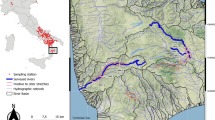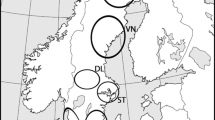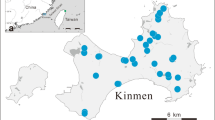Abstract
During the last century, otter populations in the Mediterranean area of the Iberian Peninsula were dramatically reduced and disappeared in many localities. A reintroduction programme was established in north-eastern Spain (Muga and Fluvià basins and the “Aiguamolls de l’Empordà” wetlands), by releasing 42 otters from four different Iberian populations, between 1995 and 2002. In order to evaluate the success of the reintroduction programme, we investigated microsatellite variation in the native populations of released otters as well as in the population present in the release area in 2004. We used non-invasively collected samples as the DNA source to avoid disturbing the animals in the wild. Laboratory procedures included the screening of samples and a multiple-tubes approach to detect and correct genotyping errors. Our results show that founders have been replaced by descendants in the release area and the population is in Hardy-Weinberg equilibrium, with a 1:1 sex ratio. Western Iberian otters—representing two-thirds of the founder group and released earlier—have greatly contributed to the genetic composition of the current population. The genetic patterns of otters found in a basin north of the studied area suggest a common origin with the released population. We also detected in a few otters the presence of alleles not identified in the original founder group, and we shall discuss the possible origin of these alleles.


Similar content being viewed by others
References
Adams JR, Kelly BT, Waits LP (2003) Using faecal DNA sampling and GIS to monitor hybridization between red wolves (Canis rufus) and coyotes (Canis latrans). Mol Ecol 12:2175–2186
Arrendal J, Walker CW, Sundqvist AK et al (2004) Genetic evaluation of an otter translocation program. Conserv Genet 5:79–88
Belkhir K, Borsa P, Chikhi L et al (2004) GENETIX 4.05.2, logiciel sous WindowsTM pour la génétique des populations. Laboratoire Génome, Populations, Interactions CNRS UMR 5000, Université de Montpellier II, Montpellier (France)
Bellemain E, Taberlet P (2004) Improved noninvasive genotyping method: application to brown bear (Ursus arctos) faeces. Mol Ecol Notes 4:519–522
Constable JL, Ashley MV, Goodall J et al (2001) Noninvasive paternity assignment in Gombe chimpanzees. Mol Ecol 10:1279–1300
Coxon K, Chanin P, Dallas J et al (1999) The use of DNA fingerprinting to study the population dynamics of otters (Lutra lutra) in southern Britain: a feasibility study. Research & Development Technical Report W202. Environment Agency, Bristol, UK
Creel S, Spong G, Sands JL et al (2003) Population size estimation in Yellowstone wolves with error-prone noninvasive microsatellite genotypes. Mol Ecol 12:2003–2009
Dallas JF, Piertney SB (1998) Microsatellite primers for the Eurasian otter. Mol Ecol 7:1248–1251
Dallas JF, Bacon PJ, Carss DN et al (1999) Genetic diversity in the Eurasian otter, Lutra lutra, in Scotland. Evidence from microsatellite polymorphism. Biol J Linn Soc Lond 68:73–86
Dallas JF, Carss DN, Marshall F et al (2000) Sex identification of the Eurasian otter Lutra lutra by PCR typing of spraint. Conserv Genet 1:181–183
Dallas JF, Coxon KE, Sykes T et al (2003) Similar estimates of population genetic composition and sex ratio derived from carcasses and faeces of Eurasian otter Lutra lutra. Mol Ecol 12:275–282
Davison A, Birks JDS, Brookes RC et al (2002) On the origin of faeces: morphological versus molecular methods for surveying rare carnivores from their scats. J Zool (Lond) 257:141–143
Delibes M (1990) La nutria (Lutra lutra) en España. ICONA, Madrid
Ernest HB, Penedo MC, May BP et al (2000) Molecular tracking of mountain lions in the Yosemite Valley region in California: genetic analysis using microsatellite and faecal DNA. Mol Ecol 9:433–441
Evett IW, Weir BS (1998) Interpreting DNA evidence: statistical genetics for forensic scientists. Sinauer Associates Inc., Maine
Fedriani JM, Kohn MH (2001) Genotyping faeces links individuals to their diet. Ecol Lett 4:477–483
Fernández-Morán J, Molina L, Flamme G et al (2001) Hematological and biochemical reference intervals for wild caught Eurasian otter from Spain. J Wildl Dis 37:159–163
Fernández-Morán J, Saavedra D, Manteca-Vilanova X (2002) Reintroduction of the Eurasian otter (Lutra lutra) in northeastern Spain: trapping, handling, and medical management. J Zoo Wildl Med 33:222–227
Ferrando A, Ponsà M, Marmi J et al (2004) Eurasian otters, Lutra lutra, have a dominant mtDNA haplotype from the Iberian Peninsula to Scandinavia. J Hered 95:430–435
Frantz AC, Pope LC, Carpenter PJ et al (2003) Reliable microsatellite genotyping of the Eurasian badger (Meles meles) using faecal DNA. Mol Ecol 12:1649–1661
Goudet J (2001) FSTAT, a program to estimate and test gene diversities and fixation indices (version 2.9.3). Available from http://www.unil.ch/izea/softwares/fstat.html. Updated from Goudet (1995)
Guo SW, Thompson EA (1992) Performing the exact test of Hardy-Weinberg proportions for multiple alleles. Biometrics 48:361–372
Hájková P, Zemanová B, Bryja J et al (2006) Factors affecting success of PCR amplification of microsatellite from otter faeces. Mol Ecol Notes 6:559–562
Hedmark E, Flagstad O, Segerstrom P et al (2004) DNA-based individual and sex identification from wolverine (Gulo gulo) faeces and urine. Conserv Genet 5:405–410
Hung CM, Li SH, Lee LL (2004) Faecal DNA typing to determine the abundance and spatial organisation of otters (Lutra lutra) along two stream systems in Kinmen. Anim Conserv 7:301–311
Kohn MH, York EC, Kamradt DA et al (1999) Estimating population size by genotyping faeces. Proc R Soc Lond B Biol Sci 266:657–663
Kruckenhauser L, Pinsker W (2004) Microsatellite variation in autochthonous and introduced populations of the Alpine marmot (Marmota marmota) along a European west-east transect. J Zool Syst Evol Res 42:19–26
Kruuk H (1995) Wild otters: predation and populations. Oxford University Press, New York
Latch EK, Rhodes OE Jr (2005) The effects of gene flow and population isolation on the genetic structure of reintroduced wild turkey populations: are genetic signatures of source populations retained? Conserv Genet 6:981–997
Leberg PL (1990) Genetic considerations in the design of introduction programs. Trans Nat Am Wildl Nat Resour Conf 55:609–619
Lucchini V, Fabbri E, Marucco F et al (2002) Noninvasive molecular tracking of colonizing wolf (Canis lupus) packs in the western Italian Alps. Mol Ecol 11:857–868
Macdonald DW, Mason CF (1994) Status and conservation needs of the otter (Lutra lutra) in the western Palaeartic. Nat Environ 67:1–54
Marmi J (2004) Sistemàtica, filogeografia i genètica de la conservació de mustèlids i de macacs. PhD Thesis, Universitat Pompeu Fabra
Mills L, Citta J, Lair K et al (2000) Estimating animal abundance using noninvasive DNA sampling : promise and pitfalls. Ecol Appl 10: 283–294
Monteiro L, Bonnemaison D, Vekris A et al (1997) Complex polysaccharides as PCR inhibitors in feces: Helicobacter pylori model. J Clin Microbiol 35:995–998
Mucci N, Pertoldi C, Madsen AB et al (1999) Extremely low mitochondrial DNA control-region sequence variation in the otter Lutra lutra population of Denmark. Hereditas 130:331–336
Murphy MA, Waits LP, Kendall KC (2003) The influence of diet on faecal DNA amplification and sex identification in brown bears (Ursus arctos). Mol Ecol 12:2261–2265
Navidi W, Arnheim N, Waterman MS (1992) A multiple-tubes approach for accurate genotyping of very small DNA samples by using PCR: statistical considerations. Am J Hum Genet 50:347–359
Nei M (1978) Estimation of average heterozygosity and genetic distance from a small number of individuals. Genetics 89:583–590
Nsubuga AM, Robbins MM, Roeder AD et al (2004) Factors affecting the amount of genomic DNA extracted from ape faeces and the identification of an improved sample storage method. Mol Ecol 13:2089–2094
Paetkau D, Waits LP, Clarkson PL et al (1998) Variation in genetic diversity across the range of North American brown bears. Conserv Biol 12:418–429
Palomares F, Godoy JA, Piriz A et al (2002) Faecal genetic analysis to determine the presence and distribution of elusive carnivores: design and feasibility for the Iberian lynx. Mol Ecol 11:2171–2182
Piggott MP, Bellemain E, Taberlet P et al (2004) A multiplex pre-amplification method that significantly improves microsatellite amplification and error rates for faecal DNA in limiting conditions. Conserv Genet 5:417–420
Randi E, Davoli F, Pierpaoli M et al (2003) Genetic structure in otter (Lutra lutra) populations in Europe: implications for conservation. Anim Conserv 6:93–100
Raymond M, Rousset F (1995) GENEPOP (version 1.2): population genetics software for exact tests and ecumenism. J Hered 86:248–249
Ruiz-Olmo J (2001) Pla de conservació de la llúdriga a Catalunya: biologia i conservació. Departament de Medi Ambient de la Generalitat de Catalunya
Ruiz-Olmo J, Delibes M (1998) La nutria en España ante el horizonte del año 2000. Sociedad Española para la Conservación y Estudio de los Mamíferos, Málaga
Ruiz-Olmo J, Saavedra D, Jiménez J (2001) Testing the surveys and visual and track censuses of Eurasian otters (Lutra lutra). J Zool (Lond) 253:359–369
Saavedra D (2002) Reintroduction of the Eurasian otter (Lutra lutra) in Muga and Fluvia basins (north-eastern Spain): viability, development, monitoring and trends of the new population. Ph. D. Thesis, Universitat de Girona
Saavedra D (2006) El retorn de la llúdriga. Història de la reintroducció de la llúdriga als Aiguamolls de l’Empordà i conques dels rius Muga i Fluvià. Manuals tècnics i pràctics de la Fundació Territori i Paisatge. Fundació Territori i Paisatge de l’Obra Social de Caixa Catalunya, Barcelona
Saavedra D, Sargatal J (1998) Reintroduction of the otter (Lutra lutra) in northeast Spain (Girona province). Galemys 10:191–199
Sjöånsen T (1997) Movements and establishment of reintroduced European otters Lutra lutra. J Appl Ecol 34:1070–1080
Taberlet P, Camarra JJ, Griffin S et al (1997) Noninvasive genetic tracking of the endangered Pyrenean brown bear population. Mol Ecol 6:869–876
Taberlet P, Griffin S, Goossens B et al (1996) Reliable genotyping of samples with very low DNA quantities using PCR. Nucleic Acids Res 24:3189–3194
Taberlet P, Waits LP, Luikart G (1999) Noninvasive genetic sampling: look before you leap. Trends Ecol Evol 14:323–327
Thompson JD, Higgins DG, Gibson TJ (1994) CLUSTAL W: improving the sensitivity of progressive multiple sequence alignment through sequence weighting position-specific gap penalties and weight matrix choice. Nucleic Acids Res 22:4673–4680
Valière N (2002) GIMLET: a computer program for analysing genetic individual identification data. Mol Ecol Notes 2:377–379
Vinkey RS, Schwartz MK, McKelvey KS et al (2006). When reintroductions are augmentations: the genetic legacy of fishers (Martes pennanti) in Montana. J Mammal 87:265–271
Waits LP, Luikart G, Taberlet P (2001) Estimating the probability of identity among genotypes in natural populations: cautions and guidelines. Mol Ecol 10:249–256
Wasser SK, Houston CS, Koehler GM et al (1997) Techniques for application of faecal DNA methods to field studies of Ursids. Mol Ecol 6:1091–1097
Weir BS, Cockerham CC (1984) Estimating F-statistics for the analysis of population structure. Evolution 38:1358–1370
Williams CL, Serfass TL, Cogan R et al (2002) Microsatellite variation in the reintroduced Pennsylvania elk herd. Mol Ecol 11:1299–1310
Wright S (1969) The theory of gene frequencies. University of Chicago Press, Chicago
Acknowledgements
We wish to thank the Barcelona Zoo, the Office National de la Chasse et de la Faune Sauvage and the Musée d’Histoire Naturelle of Perpignan for providing samples, Dr. D. Saavedra, for valuable information about the reintroduction programme, J. Espigulé and B. Minobis for their valuable help during the field work, L. Julià, O. Andrés and all volunteers that participated in sample collections. We are very grateful to Dr. E. Randi and N. Mucci for a training stage on laboratory procedures. We also thank Dr. M. Bosch for comments on early drafts of the manuscript and two anonymous reviewers that greatly improved the manuscript with their comments. A. Ferrando and R. Lecis were supported by grants from the DURSI, Generalitat de Catalunya (ref. 2002FI-00280) and Ministerio de Educación y Ciencia (SB2003-0257), respectively. This study is supported by the Fundació Territori i Paisatge, Caixa Catalunya. The English of this manuscript has been read and corrected by a native, English-speaking instructor of English of this University.
Author information
Authors and Affiliations
Corresponding authors
Additional information
This paper is dedicated to the memory of Dr. Xavier Domingo-Roura.
Rights and permissions
About this article
Cite this article
Ferrando, A., Lecis, R., Domingo-Roura, X. et al. Genetic diversity and individual identification of reintroduced otters (Lutra lutra) in north-eastern Spain by DNA genotyping of spraints. Conserv Genet 9, 129–139 (2008). https://doi.org/10.1007/s10592-007-9315-1
Received:
Accepted:
Published:
Issue Date:
DOI: https://doi.org/10.1007/s10592-007-9315-1




